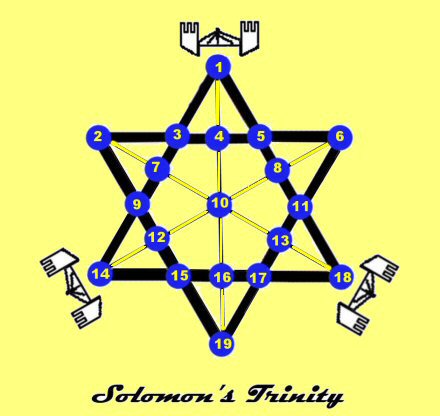
The 40th International Puzzle Party was cancelled several times because of Covid-19 and was finally rescheduled for Jerusalem, Israel, for August 2023. As much as Kate and Dick Jones like to travel all over the world, the distance to Israel under the uncertain world conditions of these years kept them from attending in person. However, Kate likes to design puzzles for the IPP that capture the theme of the location, and a Star of David gameboard was irresistible.
Jerusalem is one of the very oldest cities in the world, inhabited since around 3000 BC (over 5000 years!) and is the founding center of the world's three major monotheistic, Abrahamic religions: Judaism, Christianity, and Islam. Abraham is credited with starting that whole history by reporting conversations with God and passing the belief on through his descendants, the most famous of whom was Solomon, the son of David (whose star emblem is one of the most famous symbols on earth). We are happy to give Solomon name credit herewith for the puzzle.
Each religion has its own name for its God, even while professing there is only one, and that all three are the same entity. From Judaism we get Yahweh; Christians have Jehovah; and Muslims have Allah.
Tracing historically how beliefs arose and spread is an as yet unfinished puzzle for humanity. In recognition of this cosmic conundrum, Kate's design invites all three godly characters to partake of the puzzle titled "Solomon's Trinity". Here is the grid on which to play it:

On this gameboard will be the three deities, each a different color pawn starting from a different palace. There are 16 stones off the board to be placed as the deities take turns making moves. The goal of the puzzle is to fill the board. If played as a competitive game for two or more players, the goal is to be the last player able to make a move.
To solve: Designate the three characters by color, place their pawns by their palaces, and have them take turns in that order. Move the first pawn along a straight line any open distance to another empty circle. Place a stone on the circle where this move started.
The next pawn moves to an open space on its line, placing a stone on the space it left. Continue as long as possible. If a pawn is blocked in, it passes until and unless a space opens again when another piece moves.
If a pawn is blocked by only one stone or pawn, with an open space on the same line on the other side of the blocking piece, the pawn jumps over that one piece and moves that piece over to where the jump started instead of adding a new stone. Likewise, if the jump was over a pawn, that pawn moves to where the jump started. When the jump has both a stone and a pawn available, it must jump over the stone.
Some careful planning is necessary to get all the stones on the board, once one or two pawns are blocked from further moves. If you get stuck, clear the board and start again. It doesn't matter where the pawns end up as long as every space on the board is filled.
Who wins?
As a strategy game for two or three or more players, start with the three pawns on their palace spaces. Take turns as in the puzzle, with the objective of being the last player able to move.
It is not necessary for the board to be filled when the game ends. There may be spaces that could not be filled before all the pawns are blockaded. The last player able to move wins and is declared "god for a day". If that idea is too irreverent, call it "winner for a day".
With 3 players, each player will move the same pawn each time. With two, four, or more players, move the next pawn whose turn it is, regardless of what color you moved last time. If you win, it's with whichever deity you happen to be operating.
. . . . .
Peg Solitaire
This classic solitaire theme works well on the Trinity board, too. Using all 18 stones (or pennies), place one stone on every circle except the center. Jump a stone over an adjacent stone to the empty space directly on its other side, as in checkers. and remove the jumped-over stone. You win if only one piece remains on the board. Only jumps are used, no steps or slides. Where possible, multiple jumps with one stone are allowed over a sequence of stones.
What is the fewest number of turns that can leave just one stone on the board? What is the longest sequence of continuous jumps?
![]()